Robots add precision and accuracy to angioplasty offer radiation protection
How new technology is enhancing angioplasty.
MEDIA CONTACT
Sabrina Childress321.841.8748
[email protected]
ORLANDO, Fla. (February 12, 2014) — Robots in the cath lab are helping clear blocked arteries in patients – reducing chest pain, shortness of breath, and risks for heart attacks. The Orlando Health Heart & Vascular Institute is the first in the state of Florida, to offer a robotic-assisted system for coronary angioplasty. The new technology is designed to enhance angioplasty with added precision and accuracy, and less radiation exposure, as interventional cardiologists place balloons and stents inside arteries to restore blood flow to the heart.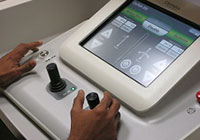
“We are leading the way to a new standard of care for interventional cardiac procedures,” said Vijaykumar Kasi, MD, PhD, interventional cardiologist, Orlando Health Heart & Vascular Institute, and director, Cardiovascular Research and Interventional Fellowship training program at Orlando Regional Medical Center. “The new technology brings together robotic precision, improved and close up views of anatomy during the procedure, and better control of balloon and stent placement, leading to better and safer outcomes for patients.”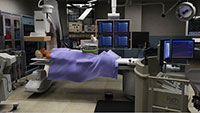
The CorPath® System by Corindus®, allows interventional cardiologists to perform angioplasty away from the patient bedside, although still in the procedure room, while seated inside a radiation-protected cockpit. Doctors use joysticks to robotically maneuver guide-wires, and place balloons and stents to widen narrowed arteries to get blood flowing. Doctors are also closer to monitors for improved visualization of the guide wires, balloons and stent during the procedure.
“The level of precision provided by the CorPath System improves control, visualization, and measurement for the physician,rdquo; said Dr. Kasi. “The accuracy and precision at the millimeter level compared to traditional methods improves the quality of the care that we provide to patients.”
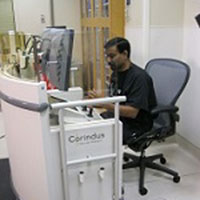
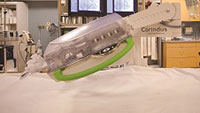
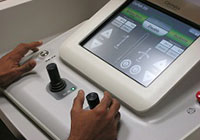
Interventional cardiologist seated in the CorPath System cockpit.
The robotic arm of the CorPath System. The console of the CorPath System from inside the cockpit.The CorPath System fixates and holds angioplasty devices at all times even when doctors’ hands are involved with other steps of the procedure. During manual procedures, the doctor and other clinicians w
would have to hold their hands steady on the guide-wires for much of the procedure in which a catheter is inserted in an artery in the groin or arm to reach the blocked artery. A balloon at the tip of the catheter is used to physically open the blockage and help improve blood flow. During an angioplasty, doctors often use stents, a wire metal mesh tube, to prop open the artery and keep it open once the procedure is complete.
Another important aspect of this new technology in cardiovascular interventions is the radiation protection it provides to patients and medical staff.
“Because the technology helps more effectively advance stents at the right angle, it potentially leads to shorter procedures and less exposure to harmful radiation,” said Dr. Kasi. “With a lead-lined interventional cockpit, the robotic-assisted technology significantly reduces exposure to radiation without the use of heavy lead apparel.”
###
About Orlando Health
Orlando Health is a $3.4 billion not-for-profit healthcare organization with more than 2,400 beds serving Central Florida and beyond. Consisting of eight wholly-owned or affiliated hospitals and rehabilitation centers, Orlando Health has the area’s only Level One Trauma Centers for adults and pediatrics, and is a statutory teaching hospital system that offers both specialty and community hospitals. They are: Orlando Health Orlando Regional Medical Center (ORMC); Orlando Health Arnold Palmer Hospital for Children; Orlando Health Winnie Palmer Hospital for Women & Babies; Orlando Health UF Health Cancer Center; Orlando Health Dr. P. Phillips Hospital; Orlando Health – Health Central Hospital; Orlando Health South Seminole Hospital; Orlando Health South Lake Hospital; affiliate, St. Cloud Regional Medical Center.
The organization includes Orlando Health Medical Group and Orlando Health Physician Associates, two of the region’s largest multi-specialty practices; a renowned cancer center – Orlando Health UF Health Cancer Center (with free-standing sites in downtown Orlando, the Dr. Phillips community in southwest Orlando, Lake Mary, Ocoee and Clermont); four outpatient surgery centers; 10 wholly-owned, affiliated or partnership urgent care centers; and a majority interest inan entity operating five outpatient imaging centers.
More than 2,900 physicians have privileges across the Orlando Health system, which is also one of the area’s largest employers with more than 20,000 employees who support our philosophy of providing high-quality care and service that revolves around patients’ needs. Orlando Health proves this everyday with more than 112,000 inpatient admissions, more than 2.4 million outpatient visits and more than 10,000 international patients each year. Additionally, Orlando Health provides more than $450 million in total value to the community in the form of charity care, community benefit programs and services, community building activities and more.
About Corindus Vascular Robotics
Corindus Vascular Robotics is the global technology leader in robotic-assisted percutaneous coronary interventions (PCIs). The company’s FDA-cleared CorPath® 200 System is the first medical device that offers interventional cardiologists PCI procedure control from an interventional cockpit. With the CorPath System, Corindus brings robotic precision to PCI procedures to help optimize clinical outcomes and minimize the costs associated with complications through improper stent placement. For additional information, visit www.corindus.com.






